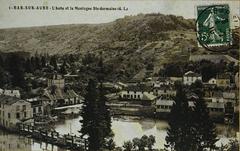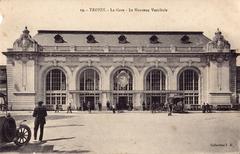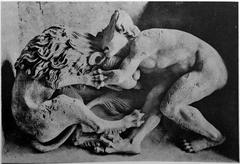Église Notre-Dame des Trévois Visiting Guide: Hours, Tickets, and Nearby Attractions
Date: 01/08/2024
Why Visit Église Notre-Dame des Trévois
Located in the vibrant city of Troyes, France, the Église Notre-Dame des Trévois stands as a testament to early 20th-century religious architecture. Designed by the renowned architect Dom Paul Bellot, this church, constructed between 1931 and 1934, showcases an innovative blend of materials and architectural styles that reflect the socio-economic context of the interwar period. Nestled in the working-class Trévois district, the church was built to cater to the spiritual needs of the local community, emphasizing the Catholic Church’s commitment to serving all segments of society (Patrimoine-Histoire).
The church is not just an architectural marvel but also a cultural landmark, recognized for its historical significance and artistic treasures. The church’s use of polychrome bricks and the intricate statue of Notre-Dame des Trévois sculpted by Henri Charlier add to its aesthetic appeal (Wikipedia). This guide aims to provide a comprehensive overview of the church’s history, architectural features, visitor information, and travel tips, ensuring that you have all the necessary details to make your visit an enriching experience.
Contents
- Introduction
- Historical Background
- Origins and Early Development
- Architectural Vision and Construction
- Architectural Features
- Historical Significance
- Preservation and Recognition
- Visitor Information
- Visiting Hours and Tickets
- Guided Tours
- Accessibility
- Travel Tips and Nearby Attractions
- Getting There
- Nearby Attractions
- Photography Tips
- FAQ
- Conclusion
Introduction
Located in the vibrant city of Troyes, France, the Église Notre-Dame des Trévois is a historical gem that offers visitors a glimpse into early 20th-century religious architecture. This article will guide you through the church’s rich history, architectural marvels, visiting hours, ticket information, and nearby attractions, ensuring a comprehensive experience for anyone planning a visit.
Historical Background
Origins and Early Development
The Église Notre-Dame des Trévois, situated at 83 Boulevard Jules-Guesde in Troyes, has a rich history that dates back to the early 20th century. Constructed between 1931 and 1934, the church was built to serve the burgeoning population in the Trévois district, a working-class neighborhood in southern Troyes. The area was known for its affordable housing and proximity to industrial facilities, necessitating a place of worship for the local community (Patrimoine-Histoire).
Architectural Vision and Construction
The architectural design of the church was led by Dom Paul Bellot, a Benedictine monk and renowned architect celebrated for his contributions to religious architecture in the 1920s and 1930s. Bellot’s work is noted for its innovative use of materials and liturgical functionality. For Notre-Dame des Trévois, Bellot employed a combination of brick and concrete, creating a structure that was both aesthetically pleasing and structurally sound (Monumentum).
The initial plans included a brick façade with two towers, known as the “Église aux Sept Douleurs” (Church of the Seven Sorrows). The cornerstone was laid on December 6, 1931, and the construction was overseen by local architect M.-J. Hugot. The project unfolded in three phases, starting with the chancel. However, due to economic constraints and the appointment of Maurice Feltin as the Bishop of Sens, the original ambitious plans were scaled down. The final design featured a simpler gable wall and an integrated bell tower (Wikipedia).
Architectural Features
One of the most striking features of the Église Notre-Dame des Trévois is its use of polychrome bricks, creating a vibrant and intricate interior. This design choice is a hallmark of Bellot’s architectural style, reflecting his interest in creating visually stimulating religious spaces. The church’s façade is adorned with a statue of Notre-Dame des Trévois, sculpted by Henri Charlier, adding artistic elegance to the exterior (Wikipedia).
The church’s layout follows a Latin cross plan, extended by a polygonal apse with five sides. The interior space is characterized by its open, uncluttered design, aligning with the liturgical reforms of the interwar period, allowing for an unobstructed view of the altar and enhancing the congregational experience during services (Monumentum).
Historical Significance
The Église Notre-Dame des Trévois holds significant historical value, both architecturally and culturally. It is one of the fifteen parish churches designed by Dom Paul Bellot, whose work is celebrated for its contribution to the liturgical and architectural renewal of the early 20th century. Bellot’s influence extended beyond France, with notable projects in the Netherlands, Argentina, and Portugal (Patrimoine-Histoire).
The church’s construction during the interwar period reflects the broader socio-economic context of the time. Building a new church in a working-class district underscores the Catholic Church’s commitment to serving all segments of society, particularly those in industrial areas. The use of modern materials and construction techniques also highlights the church’s adaptation to contemporary architectural trends (Monumentum).
Preservation and Recognition
In recognition of its architectural and historical significance, the Église Notre-Dame des Trévois was classified as a historical monument in 2001. This designation ensures the preservation of the church’s unique features, including its polychrome brick interior and the statue of Notre-Dame des Trévois. The church also holds the “Patrimoine du XXe siècle” (20th Century Heritage) label, further cementing its status as an important cultural landmark (Wikipedia).
Visitor Information
Visiting Hours and Tickets
The Église Notre-Dame des Trévois is open to visitors daily from 9:00 AM to 7:00 PM. Admission is free, but donations are welcome to support the church’s maintenance and community programs. Special events and services may alter these hours, so it’s advisable to check the church’s official website or contact them directly for the latest information (Notre-Dame des Trévois).
Guided Tours
Visitors can enhance their experience with guided tours offered by the church. These tours provide in-depth insights into the church’s history, architecture, and cultural significance. Tours are available in both French and English and can be booked in advance through the church’s website.
Accessibility
The Église Notre-Dame des Trévois is committed to inclusivity and has made efforts to be accessible to visitors with mobility challenges. Ramps and designated seating areas ensure that all visitors can comfortably explore the church.
Travel Tips and Nearby Attractions
Getting There
The church is conveniently located in Troyes and can be easily accessed by public transport, car, or on foot from the city center. Ample parking is available nearby for those driving.
Nearby Attractions
While visiting the Église Notre-Dame des Trévois, take the opportunity to explore other historical sites in Troyes. The Cathedral of Saint Peter and Saint Paul, the Museum of Modern Art, and the charming medieval old town are all within close proximity and offer a rich cultural experience.
Photography Tips
The church’s unique architectural features and vibrant interiors make it a fantastic subject for photography. Visitors are encouraged to capture the beauty of the polychrome bricks and the intricate details of the statue of Notre-Dame des Trévois. Respectful photography is permitted, but please avoid disturbing ongoing services.
FAQ
Q: What are the visiting hours for Église Notre-Dame des Trévois? A: The church is open daily from 9:00 AM to 7:00 PM.
Q: Is there an admission fee? A: Admission is free, but donations are welcome.
Q: Are guided tours available? A: Yes, guided tours are available in French and English and can be booked through the church’s website.
Q: Is the church accessible for visitors with mobility challenges? A: Yes, the church has ramps and designated seating areas for visitors with mobility challenges.
Conclusion
The Église Notre-Dame des Trévois stands as a testament to the architectural innovation and cultural significance of early 20th-century religious buildings. Its rich history, unique design, and ongoing community role make it a must-visit destination for anyone interested in the heritage of Troyes. Whether you are an architecture enthusiast, a history buff, or a spiritual seeker, the Église Notre-Dame des Trévois offers a profound and enriching experience.
For more information, visit the church’s official website and follow them on social media for updates on events and services. Don’t forget to explore other related posts on our site and download our mobile app Audiala for more travel tips and historical insights.
Sources and Further Reading
- Patrimoine-Histoire. (n.d.). Église Notre-Dame des Trévois. Retrieved from Patrimoine-Histoire
- Wikipedia. (n.d.). Église Notre-Dame des Trévois. Retrieved from Wikipedia
- Monumentum. (n.d.). Église Notre-Dame des Trévois. Retrieved from Monumentum
- Explore Grand Est. (n.d.). Culture Bubbles: Notre-Dame des Trévois Church. Retrieved from Explore Grand Est




